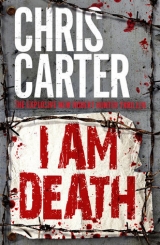
Текст книги "I Am Death"
Автор книги: Chris (2) Carter
Жанры:
Триллеры
,сообщить о нарушении
Текущая страница: 4 (всего у книги 47 страниц)
Ten
The day outside was bright and warm, with a cloudless blue sky that could’ve belonged in the Caribbean. Even at that time in the morning, and with the breeze that blew from the west, temperatures were already getting up to 68°F.
Garcia drove while Hunter re-studied Nicole Wilson’s fact sheet and the photographs in both files the captain had given them. As they merged on to Harbor Freeway, heading towards the airport, Hunter’s cellphone rang inside his pocket.
‘Detective Hunter, Homicide Special,’ he answered on the second ring.
‘Robert, it’s Doctor Carolyn Hove at the LA County Coroner.’
‘Oh, hi, Doc.’ Hunter wasn’t expecting her call so soon.
‘I’m not sure if “welcome” is the right word, but . . . welcome back.’
‘Thanks.’
Doctor Hove sounded tired, which Hunter knew wasn’t that unusual due to her workload and the problems she faced when it came to sleeping. Not that she had ever discussed it with him or anyone else for that matter, but Hunter knew about her husband, and he had recognized the telltale signs of insomnia over a year ago, just after her loss. He was well qualified to do so.
Hunter was an insomniac himself. He had struggled with it most of his life. It’d started mildly, just after his mother lost her battle with cancer. As the years went by it intensified, but Hunter quickly learned that his insomnia was nothing more than his brain’s defense mechanism so he didn’t have to deal with the ghastly nightmares that tormented him almost every night. Instead of fighting it, he simply learned to live with it. He could survive on three, sometimes two hours of sleep a night for weeks.
‘I just finished the autopsy on case 75249-6. Young female identified as Nicole Wilson. According to the case file, you’re the lead, is that correct?’
‘Yes, that’s right.’
‘OK.’ Hunter heard the sound of pages turning. ‘I think that you’ll want to have a look at what I found, Robert.’
‘Sure, Doc. But we’re just on our way to the location where the body was found. We’ll drop by the morgue in, let’s say –’ he consulted his watch – ‘two hours, give or take.’
There was a heavy pause. When Doctor Hove spoke again, there was something else in her tone of voice – trepidation – that was very unusual.
‘Trust me, Robert, I really think that you should have a look at this first.’
Eleven
The main facility of the Los Angeles County Department of Coroner on North Mission Road was an impressive building, both in size and architecture. Showing hints of Renaissance and neoclassicism, the large hospital-turned-morgue was fronted by terracotta bricks with light-gray details. Old-fashioned lampposts flanked the extravagant entrance stairway, and from the exterior alone one would be forgiven for thinking that the inspiration for such lavish design had come from the old town of Prague, or the historic universities of Oxford.
Garcia parked in the area reserved for law enforcement officials and both detectives took the stairs up to the main building in a hurry. They pushed open the large glass doors that led into an awfully busy, but pleasantly air-conditioned, lobby and stepped inside.
Neither Hunter nor Garcia were too surprised as to the number of people mingling around the reception foyer. As the busiest coroner in the whole of the USA, the Los Angeles County Department of Coroner could receive anywhere up to one hundred bodies a day. The LACDC was also the only department of coroner in the country with an official gift shop, where one could purchase sweatshirts, baseball caps, mugs, skeleton bones and a multitude of other items, all carrying the legitimate logo of the Los Angeles morgue.
Hunter and Garcia zigzagged their way through a group of Japanese tourists and approached the main reception counter. The middle-aged African-American woman behind it looked up from her computer screen, removed her reading glasses and gave them a smile that was both warm and sorrowful at the same time.
‘Hello, gentlemen, how can I help you?’ She spoke in the same tone and volume as a librarian.
Morgue receptionists’ greetings were pretty much the same all over the USA. They never greeted anyone with the words ‘good morning’, ‘good afternoon’, or ‘good evening’. Usually, a person visiting a morgue would struggle to find anything good about the day they were having.
‘LAPD Detectives Hunter and Garcia to see Doctor Carolyn Hove,’ Hunter said, producing his credentials. Garcia did the same.
‘She’s expecting us,’ Hunter added.
The receptionist allowed her eyes to hover over both detectives’ badges for a moment before reaching for the phone on the counter in front of her, but before she was able to dial the heavy metal door on the east wall was pushed open by Doctor Hove herself.
‘Robert, Carlos,’ she said. ‘You guys made it in good time.’
Doctor Hove wore a white lab coat with a photo card clipped to her left pocket. She was holding a blue file in her right hand.
‘Hey, Doc,’ Hunter and Garcia said at the same time, greeting her warmly.
Doctor Hove was a tall and slim woman with deep penetrating green eyes. Her long chestnut hair was bundled up into a bun and tucked under a factory-style hairnet. A surgical mask hung from her neck.
‘Once again,’ she said. ‘I’m not sure if this really applies, but . . . welcome back, both of you.’ She paused and her eyes narrowed a fraction as she looked at Hunter. ‘Though, I must add that you don’t look like you just came back from a break, Robert. Are you sure you’ve been away?’
‘Oh, I’m sure.’
Garcia stifled a smile.
‘So,’ Hunter asked, his eyes focusing on the file in her hand. ‘What have you found, Doc?’
She didn’t follow his gaze. Instead, she tilted her head in the direction of the door she’d just come out of.
‘I think you both better come with me.’
Twelve
Hunter and Garcia followed Doctor Hove past the reception counter, through a set of double swinging doors and into a wide corridor with strip lights on the ceiling and shiny floors.
As they entered the corridor, they were all greeted by a cold, antiseptic odor that lingered in the air and scratched the inside of their nostrils as if it were alive.
Hunter hated that smell. No matter how many times he’d been through these corridors, he just couldn’t get used to it. He subtly scratched his nose and did his best to breathe only through his mouth.
They passed a couple of closed doors with frosted-glass windows on the left side of the corridor, before turning right at the end of it and into a second, narrower hallway. There they came across three lab technicians, also in white medical scrubs, standing around a coffee machine. None of them looked their way.
They pushed through a set of double swinging doors and, as they did, they all had to squeeze against the wall and wait for a trolley wheeled by an orderly to go past. The body on the trolley was covered by a white calico sheet. Balanced on its torso was a box of test tubes containing blood and urine.
Garcia made a face and looked the other way.
At the end of that corridor, they finally reached a small anteroom. Another set of double doors with two small frosted-glass windows stood directly in front of them. Above the doors, in big black letters, a plate read – Autopsy Theater One.
‘Here we are,’ Doctor Hove said, as she punched a six-digit code into the keypad to the right of the door. It buzzed loudly, and then the door unlocked with a hiss like a pressure seal.
Most people who have never been inside an autopsy room would expect the air to be heavy with the smell of a compound like formaldehyde – something many associate with biomedical labs and the preservation of a body or part of it, human or otherwise. Instead, Hunter detected a faint scent of antiseptic and industrial soap. The temperature inside the autopsy rooms was also a few degrees below what would be considered comfortable. Within minutes, an unprepared visitor would be shivering in here from the temperature alone.
The room was relatively spacious. A large double sink hugged the west wall, with a central channel that led to a drain. Next to it was a metal counter with a multitude of tools, including a Stryker saw. Parked against the north wall, in neat rows, were three empty trolleys. The center of the room was taken by two stainless-steel examination tables. The body on the furthest of the two was completely covered by a white sheet. Just above the table, circular and powerful halogen lights were suspended from the ceiling.
Doctor Hove gloved up and approached the table. Hunter and Garcia followed, each grabbing a pair of latex gloves themselves.
The doctor positioned herself on the other side of the table from the two detectives and pulled back the sheet, revealing Nicole Wilson’s naked body. Her skin had begun to turn a pale, ghostly shade of white. Her eyes had sunk deeper into their sockets, and her thin lips had now lost all color. Her hair looked wet and messy, with some of it sticking to the sides of her face. Clearly visible was the large Y incision that started at the top of each shoulder, ran down between her breasts and the front of her stomach, and concluded at the lower point of her sternum. A second large incision had also been made around her head, running across the top of her forehead to open her cranium, which indicated that her brain had been examined. Hunter found that a little peculiar, but he knew the doctor would explain it in due time. Both incisions had been stitched up with thick, black surgical thread. All that gave Nicole’s body a plastic, Frankenstein-mannequin look, a far cry from the person she had once been.
As the white sheet was pulled back, Hunter and Garcia paused, looked at each other for a split second, then back at the body. What caught them by surprise wasn’t the ugliness of the two incisions, or the roughness of the black thorn-like stitches. They had seen those more times than they cared to mention. What had made them pause was the incredible number of open wounds that covered most of the victim’s torso and thighs. They all looked to be fresh lacerations, probably no more than three to four days old, varying in sizes and orientation – some were horizontal, some diagonal, some vertical.
‘What the hell?’ Garcia breathed out.
‘I know,’ Doctor Hove agreed. ‘I was as surprised as you are when I undressed the body as I prepped it for the post mortem earlier today.’
Both detectives approached the table, bending down slightly to have a better look at the cuts.
‘What we have here is a combination of two types of wounds,’ the doctor announced. ‘As you can plainly see, they all vary in size – the smallest being just over an inch long, and the largest measuring five and three quarter inches. No two lacerations are the exact same size.’
She placed her fingers over the sides of one of the cuts and pressed it down, spreading it open.
‘None of the cuts is deep enough to have reached a major organ, artery or vein.’
She repeated the process with a couple more cuts.
‘They’re essentially all flesh wounds.’
‘Torture,’ Garcia stated rather than asked.
‘No doubt,’ Doctor Hove replied.
‘You said that they were a combination of two types of wounds,’ Hunter queried. ‘What do you mean, Doc?’
Doctor Hove shrugged and tilted her head to her left. ‘To be more precise, not two types of wounds, but wounds inflicted by two different instruments.’
Garcia repositioned himself by the foot of the examination table.
‘Some, like this one for example,’ she indicated a diagonal wound just above the body’s right nipple, which looked to be about three inches long, ‘were made by a laser-sharp instrument. Maybe a kitchen knife, or perhaps a surgical scalpel. Very clean. No serrated edges. Further analyses showed that some of the cuts created by such an instrument were made from right to left, some from left to right. The ones that aren’t horizontal in orientation also vary. Some were made starting at the highest point and moving down. Some, the exact opposite.’ Doctor Hove moved her index finger from the lowest point of the wound to the highest. ‘That makes it impossible for us to tell if the assailant was right or left-handed. To me, it looks like the killer was having fun. He enjoyed torturing her.’
Hunter and Garcia kept their full attention on the body.
‘He took his time,’ Hunter added, his eyes tracing the cuts. ‘To him it was almost like putting brush strokes on to a canvas.’
‘There’s no doubt that he took his time,’ the doctor confirmed. ‘As I’ve said, some of the cuts were made by a very sharp instrument, but not all of them.’ She directed their attention to the lower half of the body. ‘Like most of the wounds inflicted on her legs and back.’
Hunter took a step closer to examine the wounds to her thighs. Neither detective was surprised to hear that the victim also had lacerations to her back.
‘These cuts weren’t created by a sharp instrument,’ Doctor Hove continued.
‘So what was used?’ Garcia asked.
‘A whip.’ The answer came from Hunter. He had seen similar injuries before.
‘That’s correct,’ the Doctor agreed. ‘But not the kind used for sexual play, or what have you. What was used here was a proper leather bullwhip. The kind used to tame animals. I counted and recounted them. She received sixty lashes. But they were expertly controlled. Hard enough to break the skin and cause extreme pain, but light enough so it wouldn’t cut too deep into her flesh and cause excessive bleeding. That would’ve no doubt driven the victim into unconsciousness too often. He didn’t want that to happen. The same level of control was applied to the laser-sharp cuts which, by the way, also amount to sixty – hard enough to break the skin and rupture flesh to cause pain, but light enough to not cause excessive bleeding.’ Doctor Hove lifted her finger to emphasize her next point. ‘The interesting thing here is, healing progress differs slightly from one batch of wounds to another.’
‘Batch of wounds? What do you mean, Doc?’ Garcia asked.
‘Front of the torso, back of the torso, front of the legs, back of the legs, and buttocks.’ The doctor paused, her words hanging in the air for a moment, like smoke. ‘And that means that they were inflicted upon her at different times, most probably daily. In my opinion, she was flogged and tortured for five days, give or take a day.’
‘Was she sexually assaulted?’ Hunter asked.
‘Repeatedly. But unfortunately for us the assailant was careful enough to protect himself. I could recover no trace of semen, foreign blood, or any other bodily fluids.’
As a sign of respect, the room went silent for a moment.
Hunter walked over to where Garcia was and bent over to have a closer look at the victim’s neck.
‘I found no signs that she was either strangled or suffocated,’ the doctor added, anticipating Hunter’s question. ‘X-rays also revealed no broken bones. Toxicology will be another day or two, and if the killer used any sort of drugs on her prior to her death we should get a result for traces of it soon enough, but we won’t get a positive result for poisoning. That’s not how she died.’
‘So what was the cause of death, Doc?’ Garcia asked.
‘I’ll get there in a minute, Carlos,’ Doctor Hove said, paused, and called their attention to the marks on the body’s wrists, ankles and cheeks. ‘First let me show you a peculiarity about these. These marks indicate that she was very tightly restrained, and for a considerable amount of time. Most certainly while she was being tortured and violated. The restraint used on her wrists was some sort of thin rope. Probably nylon. Probably very easy to obtain from a multitude of stores. But I found no residues to examine, so that’s just an educated guess.’
‘On her wrists?’ Garcia asked with a frown.
Doctor Hove nodded. ‘And that’s what I mean by peculiarity. Her captor used different restraints on her ankles – stronger, harder, thicker. From the pattern left on her ankles, I’d say he used a metal chain.’
‘And why would he do that?’ Garcia again. ‘I mean, why two different types of restraints?’
Doctor Hove allowed her gaze to move around the room aimlessly, almost as if she was trying to pass the question on.
‘More torture,’ she finally replied. ‘The kind that won’t show externally.’
‘Whoa.’ Garcia lifted a hand. ‘Are you saying that her internal organs were also damaged? I mean, due to torture?’
‘One was,’ Doctor Hove replied. ‘And that’ll finally bring us to the cause of death, which baffled me throughout the entire post mortem examination until I examined her brain.’
Doctor Hove’s words seemed to chill the air inside the autopsy room even further.
‘Her brain showed signs of being damaged?’ Garcia asked. His eyes moved to Nicole’s head. ‘With no visible external trauma? Was her cranium injured?’
‘No. Her cranium was intact.’
Garcia raised his eyebrow questioningly.
Doctor Hove retrieved two sheets of paper from the instrument table behind her and handed one to each detective. ‘What caused her death was oedema of the brain.’
Garcia frowned at the sheet. ‘Wait a second, Doc, isn’t oedema some sort of swelling?’
‘Well, swelling is a consequence of it,’ the doctor clarified. ‘More precisely, oedema is an excessive build-up of fluid in the body’s tissues, which will often cause swelling and can result in further damage. It’s most common in the feet and ankles, but it can occur anywhere in the body – the lungs, the eyes, the knees, the hands, and in rarer cases, the brain.’
‘So you’re saying that her brain swelled up because of fluid excess?’ Garcia again.
‘That’s correct.’
‘What sort of fluid?’
‘Her own blood.’
Thirteen
Garcia looked at Hunter, then at the body, then back at Doctor Hove.
‘She died due to an excessive build-up of her own blood inside her brain?’ he asked. ‘And that was induced by the killer? How?’
‘By keeping her upside down for long enough,’ Hunter answered in a subdued voice. ‘That would explain the difference in restraints from her wrists to her ankles. They needed to be stronger to be able to hold her body weight.’
‘Correct again, Robert,’ Doctor Hove agreed, moving closer to the head of the examination table, and resting her hands by Nicole’s ears. ‘If you understand the process, oedema of the brain isn’t very difficult to achieve. You see, it all rests on the difference between arteries and veins. Arteries are thick-walled vessels that carry blood away from the heart and into the organs of the body.’ Like a medical professor addressing her students, she pointed at Nicole’s chest, and then moved her hand away, spreading her fingers at the same time as she explained. ‘Even upside down, the heart will continue to distribute blood through the arteries just as strongly as it would right side up. That blood travels with a lot of pressure, due to it being forced into the arteries by the pumping of the heart. So, right side up, upside down . . . it makes no difference. Blood will always travel with the same force away from the heart. Veins, on the other hand, are thin-walled vessels that carry blood from the organs of the body back into the heart for repumping. They have essentially no pressure in them, and they rely on gravity, inertia and the force of skeletal muscle contractions to help push blood back to the heart.’
Doctor Hove coughed to clear her throat before continuing.
‘With no skeletal muscle contractions happening inside the skull, if you reverse gravity by placing someone upside down for long enough, blood will still travel normally from the heart, through the arteries, and into the brain, but it will cease to travel through the veins back to the heart. So what you have is a build-up – blood coming into the brain, but not getting out.’
The doctor paused, the look on her face just a little more somber than a moment ago.
‘With a build-up of blood in the brain, after a while blood will start to leak from the capillaries, accumulating inside the cranium, increasing pressure, and causing the brain to swell. And with that comes a hell of a lot of pain – head, ears, eyes, nose . . . every heart pump would probably feel like thunder was exploding inside her head. All the killer had to do was suspend her by her feet, nothing else. Gravity does the rest. He didn’t even have to be in the room anymore. The pressure would’ve just kept on building up inside her head until it brought her gradual loss of consciousness, and then finally death as the brain would signal either respiration to fail, or the heart to stop pumping blood.’
Uneasily, Hunter shifted his weight from one foot to another.
‘How long?’ Garcia asked. ‘How long before she died? How long could one stand all that pain before the gradual loss of consciousness and death?’
Doctor Hove gave the detective a subtle, unsure headshake. ‘It would depend on several factors, Carlos, like strength and health of the victim. She appears to have been very healthy – good muscle tone, non-smoker, strong lungs, healthy liver and kidneys. But even if I’m wrong, the killer could’ve prolonged the whole process for as long as he wanted simply by returning her to a right-side-up position, decreasing the pressure in her brain, and then starting it all over again an hour or so later.’
‘Do you have an approximate time of death?’ Hunter asked.
‘Supposing that her body was always kept at room temperature after death,’ the doctor explained, ‘and I found no indication to the contrary, I’d say that she’s been dead for about thirty hours, give or take a couple.’
Hunter and Garcia knew that Nicole Wilson had been abducted seven days prior to her body being found, which meant that her killer could indeed have tortured her for five and a half consecutive days.
Before she spoke again, Doctor Hove took in a deep breath and held it for several seconds.
‘But that’s not all,’ she finally said.
Hunter and Garcia both looked at her, surprised.
‘Everything I’ve told you about this victim . . . about how she was tortured, about how she was murdered . . . I’d say none of it is scary in comparison to this.’
‘In comparison to what, Doc?’ Garcia asked.
The doctor turned and retrieved something else from the instrument table behind her – a clear plastic evidence bag containing a white piece of paper.
‘To this.’
‘And what is that?’ Hunter this time.
Doctor Hove looked down at the evidence bag for a couple of seconds before locking eyes with Hunter.
‘This is a note from the killer. He left it lodged inside her throat.’
‘Wait. What?’ Garcia asked, lifting a hand as if he hadn’t heard it properly.
Hunter didn’t move.
‘This piece of paper was first rolled up into a tube,’ the doctor explained, ‘then carefully inserted into the victim’s throat.’ She handed the plastic evidence bag to Hunter. ‘The note speaks for itself.’
The piece of paper inside it was about eight inches long by five wide. Plain white. No lines. Across the center of it, written in blood, were three words.
I AM DEATH.








